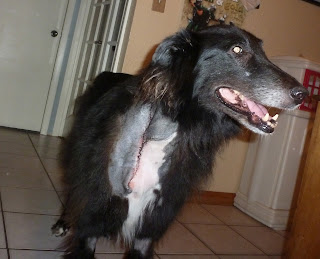Most dog and cat owners who have pets that shake their heads or paw at their ears think first of mites. Ear mites are like disgusting tiny crabs which live in the ear. They can cause intense itchiness and pawing at the head. Ear mites are more common in kittens and stray dogs and cats, since you have to catch them from close contact with another infected animal. Ear mites are NOT common in adult cats and dogs; they typically have allergies or infections (or infections caused by allergies) causing their discomfort.
This is important, because many pet owners will treat their pets ear scratching with over-the-counter ear mite medicine, and then be surprised when it doesn't work.
However, bunnies are a different matter, Especially rabbits that have been bought off of Craigslist (more on Craigslist in a future post.)
Dutchess had crusty, scabby painful ears since the owner purchased him. On exam, we first discovered Dutchess had testicles, and should be named Dutch. It may sound funny, but it is fairly common for many owners to find out that their "Petunia" is actually "Pete" the first time they come for an appointment.
 |
| Dutch, a little insecure in his masculinity after being mistaken for a girl for almost a year |
Dutch's ears were itchy, and the scabbing was painful. We did get a small sample to examine under the microscope, and it confirmed what we highly suspected. Ear mites in rabbits can become severe, eventually spreading outside the ear across the face. Luckily, they are easily treatable with medication and good cage hygiene.
 |
| Ear Yuck |
That would make my ears itchy. There is a 1993 Journal of the American Veterinary Medicine Association (JAVMA) , article about a veterinarian who infected himself with cat ear mites. He reported, besides the intense itchiness from the mites biting the insides of his ears, that he could feel the mites crossing over his face from one ear to the other while he slept, and could hear the crunching noise as they scrabbled through his ear canal. He treated himself, and then reinfected himself, several times. Surprisingly, after the first few times he infected himself, the itching started to lessen, and he became a chronic ear mite carrier.
So, besides the fact the ear mites are completely disgusting and vile, we have learned that there are veterinarians who are much much more dedicated to their job than I am. Beyond any self-preservation, I am married, and while my wife is very nice, she does have her limits. I would prefer to stay married; do not expect me to add to the human self-inflicted-ear-mite research.
If you still need to be grossed out further, here is a case of inadvertent human ear mite infection.















